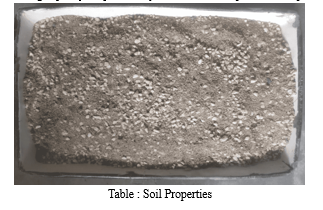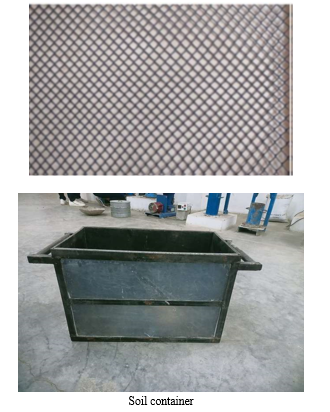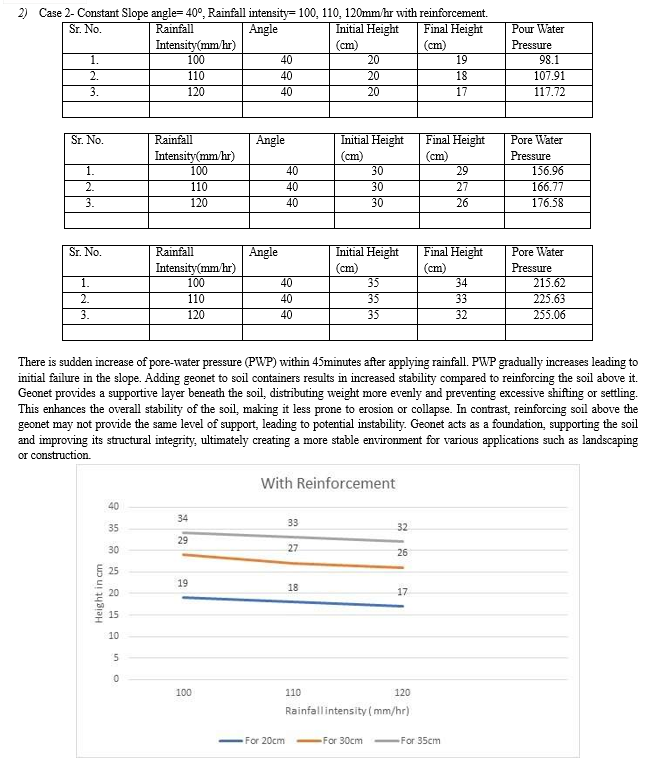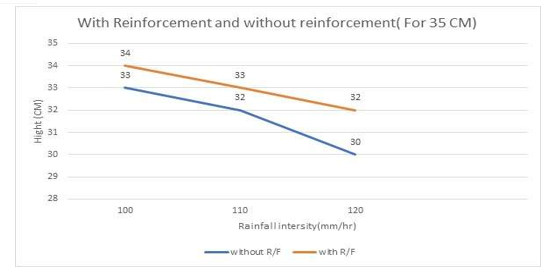Ijraset Journal For Research in Applied Science and Engineering Technology
- Home / Ijraset
- On This Page
- Abstract
- Introduction
- Conclusion
- References
- Copyright
Experimental Study of Model on Soil Slope Failure Subjected to Artificial Rainfall
Authors: Prof. Vishal Ghutke , Sarika Modak, Tejas Saratkar , Abhijeet Ade , Prashant Bodalkar
DOI Link: https://doi.org/10.22214/ijraset.2024.61741
Certificate: View Certificate
Abstract
The paper\'s purpose is to introduce a miniature form of slope for the study of infiltration process under various rainfall conditions. To mimic the infiltration process on a slope, we utilize artificial precipitation by using a sprinkler to model it. system at a rainfall intensity, ie, 100,110,120mm/h. Pore-water pressure (PWP) and displacements are measured by scale, is put in the model at different spots to track alterations. The purpose is to investigate the effects of slope movements on soil water content, pore-water pressures and. movement in both conditions, with and without geonet placement. The research attempts to forecast slop failure initiated by excessive precipitation by continuously observing these measures. From the outcomes, time to first failure can be assessed.
Introduction
I. INTRODUCTION
The introduction of the experimental study on soil slope behavior under varying rainfall intensities is designed to address critical issues related to slope stability and erosion. Soil slopes are susceptible to changes in environmental conditions, and rainfall intensity is a key factor influencing slope behavior. This project seeks to bridge existing knowledge gaps by conducting a comprehensive experimental investigation. The introduction outlines the significance of understanding soil-slope dynamics, emphasizing the potential consequences of slope instability such as landslides and erosion. It underscores the relevance of the study in the context of geotechnical engineering and natural hazard management. The paragraph aims to create awareness about the project's importance, laying the foundation for the subsequent detailed exploration of the experimental methodology and expected outcomes.
Kerala has gone through large amount of destruction and damage causing difficulty to human life, due the rainfall that place in monsoon, 2018. Recently, landslide had occurred in many part of the state. The landslide has occurred mainly in mountainous region which consist of debris, rock mass, etc., where now the place is beyond recognition. This landslide has occurred mainly due to incease in water level beyond the ground level and extreme increase in water level at river banks.
The major occurrence for slope failure is due the change of climate, increase in water level, improper drainage facilities and lack of study at the site. Initially, soil at the toe of the slope saturate faster at a higher rate and then saturate further area of slope which led to slope failure. Slope stability analysis is based on balancing of forces, moments or energy where failure is assumed to occur along slip surface. Fig. 1 shows the slope failure that took place at Kullanpadi- Muttakuzhi at Konni, Pathanamthitta.
The main objective of this paper is to identity the engineering properties of soil opted for slope failure study and to create a laboratory model for understanding slope stability. To study the properties of the slope which happened to fail on providing rainfall at a intensity, thereby, to measure pore-water pressure (PWP) and displacement dissipation during failure conditions. Also, to understand slope failures type under rainfall infiltrations is necessary to study. failure that took place at Kerala.
- Landslide caused collapse to many structures and roadways due to the movement of water.
- This leads to loss of life and property, damage to natural resources and damage to roads, bridges, etc.
- Properties of soil at various depth can be improved using geotextile agents.
- Non woven geotextile is used to improve drainage facilities and improve barrier effect
II. LITERATURE REVIEW
- Behaviour analysis by model slope experiment of artificial rainfall . Author: Cheol perk
Methodology: the sand is used as granite soil which is well graded soil. The soil container size 2× 1 × 0.6 m and rainfall intensity 30 mm/hr.
2. Effect of rainfall on stability of soil slope. Author: baraza Malla
Methodology: by using saturated an unsaturated soil and coarse graine soil. Numerical modelling by using GeoStudio software. Rainfall intensity was 36 mm / hr.
3. Model study on slope failure subjected to rainfall. Author: karuna Elizabeth Chacko
Methodology: the slope model constructed in steel platform with transparent glass surface.
Laterite soil is used and slope angle 45 degree and intensity of rainfall 133 mm/ hr. Slope is constructed with and without core geotextile.
4. Unprecedented heavy rainfall event over Yamuna Nagar. Author: G.P. Singh
Methodology: rainfall intensity was observed 365 mm/ hr and soil is unsaturated.
5. Title: Effect of rainfall characteristics on the stability of tropical residual soil slope. Author: Haryanto Recardo. Methodology: In this experiment residual soil is used. Rainfall intensities 22mm/ hr and 36mm/ hr is taken.27degree slope angle is provided.
6. Title: Centrifuge modelling of induced slope failure In variable saturated soil. Author: Shun Wang
Methodology:- The size of soil container is used 480×155×450mm, which is made by aluminium alloy. Two pairs of wooden templates with slope angle 35 degree and 45 degree are used. A wide range of rainfall intensities from 2.5 to 30 mm/ hr simulated.
7. Title: Model experiment on rainfall influence slope failures with moisture content measurements. Author: Irfan Ahmed Memon. Methodology. This experiment is conducted in laboratory flume, which is dimension of 2×1×2.1 m. The soil placed in flume parallel to slope base and slope inclination as fixed with 45 degrees. In this experiment artificial rainfall applied by installing the small sprinklers at top of theslope.
III. AIM
Experiment study of model on soil slope failure subjected to artificial rainfall .
IV. OBJECTIVES
- To study the effect of displacement on soil slope model under rainfall intensity .
- To study the effect of constant slope angle inclination on soil slope model under rainfall intensity.
- To study the effect of reinforcement materials and geotextile materials .
V. MATERIALS REQUIRED
The soil was taken from the bed of a river near Visvesvaraya National Institute of Technology, Nagpur. The test for rainfall intensity is known as model test carried on soil slope model made at different inclinations to observe displacement and check stability of the model for equipment has been used in this testing process. The various Materials which was needed to complete this testing process are mentioned below.
- Sand
The sand we gathered for experimental studies was taken from a nearby river bed. This sand had been cleaned and dried in open air before use. The sand used in the experiment is a mixture with 80% fine sand and 20% gravel proportion.
The very limited number of soil tests that get executed, these are done for determining the properties. The analysis of results provides data needed to calculate bearing capacity, slope stability and lateral earth pressures on pavement design.

Table : Soil Properties
|
SOIL PROPERTIES |
SYMBOL |
UNIT |
TEST RESULT |
|
|
Cohesion |
c |
kpa |
0.0 |
|
|
Coefficient of Curvature |
Cc |
- |
0.86 |
|
|
Uniformity coefficient |
Cu |
- |
4.05 |
|
|
Maximum density |
???????????????????? |
Kn/m3 |
17.17 |
|
|
Minimum Density |
???????????????????? |
Kn/m3 |
15.91 |
|
|
Specific Gravity |
G |
- |
2.7 |
|
|
Angle of Internal Friction |
Φ |
Dgree |
40° |
|
|
Modulus of Elasticity |
E |
Mpa |
52.02 |
|
2. Reinforcement:
Slope model can use different reinforcement as layers for stability. Geosynthetics means products made from plastic, used in many aspects but mainly for erosion control and soil stabilization plus drainage. These are open mesh-like substances consisting of integrally connected polymers. Geonets are useful in many different places. They can be used for road construction, road widening and asphalt work. They also have applications in building construction and foundations, retaining walls, dams as well as artificial ponds or water reservoirs among others.
Today, these fields have seen a growth in the creation and technique of new methods and concepts due to development of Technology, Architecture, Construction etc.. Geosynthetics is the one of the most harvests in these improvements. As mentioned above in reinforcements there are various types of geosynthetic reinforcement such as geonet/ geogrid, geotextile, geomembrane, geocomposite etc. Geosynthetics are fabricated material composed of polymer materials or are available in the form of natural materials like strips, sheets, three-dimensional structures. These helps to make construction projects more economically friendly as they are easy to organise and transport. Geosynthetics performs main five functions during construction which are insulation, reinforcement, visibility, drainage, and sealing.

VI. APPLICATION
- The application of stability analysis method is conducted for successful and effective prediction of earthquake-triggered landslides and slope failures..
- Ensure the stability of structure under short-term and long-term conditions.
- Prevent loss of human life as well as money.
- Evaluate the secure construction of human-made or natural slopes. (Earth dams, landfills, & embankments).
VII. METHODOLOGIES
- We have performed this experiment using size of soil container is 58×33×40 cm, which is one side have glass plate.
- In this experiment we have taken three soil slope angle such as constant 40. And we have taken different height consider 20, 30 & 35etc.
- We have used instrument like rain gauge to used measure the rain in mm, nozzle spray sprinkler, container and etc.
- For artificial rainfall we have used the sprinkler which is contain multiple, nozzle spray.
- The intensity of artificial rainfall measure by rain gauge in mm/ hr.
- Displacement of soil by affected due to rainfall with respect to various angle slopes have observe.
- When failure occurred then we provide the geonet or reinforcement use to increase the strength.
- The soil used in this experiment is taken form bed of river.
VIII. RESULTS ON TEST MODEL
For this test, different cases are to be considered on constructed slope on providing rainfall intensity, that is, 100,110,120 mm/h.
Using spray nozzle irrigation pipe, artificial rainfall of 100,110,120 mm/hr can be provided by spray multiple nozzles to slope constructed. This artificial rainfall gets infiltrated into the soil collected from site leading to slope instability.
IX. FAILURE SITUATION
1) Case 1: - constant slope angle 40? , rain intensity 100,110,120 mm/hr without reinforcement .
|
Sr. No. |
Rainfall Intensity(mm/hr) |
Angle
|
Initial Height (cm) |
Final Height (cm) |
Pore Water Pressure |
|
1. |
100 |
40 |
20 |
18 |
117.72 |
|
2. |
110 |
40 |
20 |
16 |
127.53 |
|
3. |
120 |
40 |
20 |
14 |
138.45 |
|
Sr. No. |
Rainfall Intensity(mm/hr) |
Angle
|
Initial Height (cm) |
Final Height (cm) |
Pore Water Pressure |
|
1. |
100 |
40 |
30 |
27 |
125.53 |
|
2. |
110 |
40 |
30 |
25 |
140.07 |
|
3. |
120 |
40 |
30 |
24 |
146.35 |
|
Sr. No. |
Rainfall Intensity(mm/hr) |
Angle
|
Initial Height (cm) |
Final Height (cm) |
Pore Water Pressure |
|
1. |
100 |
40 |
35 |
33 |
196.2 |
|
2. |
110 |
40 |
35 |
32 |
215.45 |
|
3. |
120 |
40 |
35 |
30 |
245.25 |
|
|
|
|
|
|
|
There is sudden increase of pore-water pressure (PWP) within 45minutes after applying rainfall. PWP gradually increases leading to initial failure in the slope. Due to the downward infiltration of the rainfall, maximum or initial failure was experienced at the head or crest of the slope.




Conclusion
The deformation of the height of soil is depend upon the rainfall intensity. When it rains harder, the soil height decreases over time. If it rains for a long time, the slope of the soil can fail. Heavy rainfall also increases the water pressure in the soil. With respective to constant 40-degree angle and various Hight 20,30,35CM. Using reinforcement in soil slopes increases the soil\'s strength, reducing deformation even during heavy rainfall. Without reinforcement, soil slopes can collapse even with light rainfall. Reinforcement helps stabilize the slope and gives it strength. As rainfall intensity increases, pore water pressure also rises. This means pore water pressure varies depending on both the intensity of rainfall and the soil\'s strength.
References
[1] S. Sun, S. Li, L. Li, S. Shi, J. Wang, J. Hu, C. Hu, “Slope stability analysis and protection measures in bridge and tunnel engineering: a practical case study from Southwestern China,” Springer, vol. 87(39),pp. 1-17, August 2018.11:54, 2/2/2024] Abhijeet Ade: K. H. Yanga, J. N. Thuo, V. D. A. Huynh, T. S. Nguyen, F. H. M. [2] Portelinha, “Numerical evaluation of reinforced slopes with various backfill reinforcement-drainage systems subject to rainfall infiltration,” Elsevier, vol. 20(6), pp. 457-471, 2017 [3] S. Naidu, K. S. Sajinkumar ,T. Oommen, V. J. Anuja, R. A. Samuel, C. Muraleedharan, “Early warning system for shallow landslides using rainfall threshold and slope stability analysis,” Elsevier, vol. 10, pp.1- 12, 2017. [4] H. Moayedi, B. B. K. Huat, T. A. M. Ali, A. Asadi, F. Moayedi, M. Mokhberi, “Preventing landslides in times of rainfall: case study and FEM analyses,” Disaster Prevention and Management: An International Journal, vol. 20 (2) , pp.115 – 124, 2017. [5] S. Pramusandi, I. A. Rifa, K. B. Suryolelonob, “Determination of unsaturated soil properties and slope deformation analysis due to the effect of varies rainfall,” Procedia Engineering, vol. 125, pp. 376 –382,2015 [6] M. Heibaum, “Geosynthetics for waterways and flood protection structures - Controlling the interaction of water and soil,” Geotextiles and Geomembranes, vol. 42(4), pp.374-393, 2014. [7] E. Garcia, T. Uchimura, “Study of failure mechanism in embankments Induced by rainfall infiltration by monitoring Pore water pressures and water contents,” Elsevier, vol. 74(152), pp. 125-135, 2007 [8] R. P. Orense, P. S. Shimoma, K. Maeda, I. Towhata, “Instrumented Model Slope Failure due to Water Seepage,” Journal of Natural Disaster Science, vol. 26(1), pp. 15-26, 2004. [9] S. H. Poh, B. B. Broms,lope Stabilization Using Old Rubber Tires and Geotextiles,” Journal of Performance of Constructed Facilities, vol. [10] .Brand, E. W., J. Premchitt and H. B. Phillipson, 1984. Relationship between rainfall and landslides in Hong Kong. Proceedings, 4th International Symposium on Landslides, Toronto, 377-384. [11] Chiba Prefecture Civil and River Division, 1972. Report of Disaster in Chiba due to Autumn Rain Front of September 6-7, 1971 and Typhoon No. 25 (in Japanese). [12] Farooq, K., R. Orense and I. Towhata, 2003. Response of unsaturated andy soils under constant shear stress drained condition, Soils and Foundations, 44 (2), 1-13. [13] Fukuoka, M., 1980. Landslides associated with rainfall, Geotechnical Engineering, 11, 1- Fukuzono, T., 1990. Recent studies on time prediction of slope failure Landslide News, 4, 9-12.
Copyright
Copyright © 2024 Prof. Vishal Ghutke , Sarika Modak, Tejas Saratkar , Abhijeet Ade , Prashant Bodalkar . This is an open access article distributed under the Creative Commons Attribution License, which permits unrestricted use, distribution, and reproduction in any medium, provided the original work is properly cited.

Download Paper
Paper Id : IJRASET61741
Publish Date : 2024-05-07
ISSN : 2321-9653
Publisher Name : IJRASET
DOI Link : Click Here
 Submit Paper Online
Submit Paper Online

